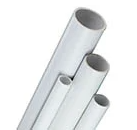As one of the most commonly used plumbing materials, PVC pipe is known for being very durable and long-lasting. In fact, PVC pipes can last about 100 years. Of course, there are a variety of factors that determine how long a particular PVC pipe will survive, including what it’s exposed to and how it’s installed. The good news is that there are a few things you can do to protect your PVC pipe and prevent it from going bad.
How long will PVC last?
 Polyvinyl chloride (PVC) piping was introduced in the 1960s as an alternative to other piping materials available at the time. These new inexpensive and durable pipes quickly became popular and are still the type of pipe most commonly used for water supply lines. While the lifespan of PVC pipes is estimated to be around 100 years, the exact lifespan is unknown as PVC pipes have not been around for that long.
Polyvinyl chloride (PVC) piping was introduced in the 1960s as an alternative to other piping materials available at the time. These new inexpensive and durable pipes quickly became popular and are still the type of pipe most commonly used for water supply lines. While the lifespan of PVC pipes is estimated to be around 100 years, the exact lifespan is unknown as PVC pipes have not been around for that long.
Of course, the natural lifespan of PVC pipes (like ours) depends on the specific use and other factors. In this article, we’ll take a look at how PVC can become weak or damaged, and how it can help prevent deterioration and extend the life of PVC in your home.
Sun exposure can damage PVC pipes
One of the most harmful things about PVC pipes is sunlight exposure. PVC that runs on the ground and is exposed to sunlight will decompose faster than normal. Ultraviolet rays from the sun can actually damage the structure of the PVC material, making it brittle and brittle.
There are ways to protect PVC piping systems—even those that must run above ground. The best way to do this is to paint the pipe or provide a covering for the exposed pipe. PVC manufacturers recommend applying a thin coat of light latex paint to protect any exposed pipes. This will prevent any discoloration of the pipes from exposure to sunlight and will help keep them strong and durable. It is also recommended that when purchasing PVC pipe, you purchase it from a supplier such as PVC Fittings Online, which stores the pipe in a covered warehouse so it is not exposed to harmful sunlight until you buy it.
Fragmentation and weather damage of underground PVC
Sunlight won’t be an issue for buried PVC piping systems, but debris, soil movement, and freezing temperatures can. Debris and rocks from pipes in the ground can cause friction that can damage PVC pipes. Also, in climates where freezing temperatures occur, PVC pipes can be at risk. When the ground freezes and thaws, it causes the soil to move, contract and expand, which can all damage the plumbing system. Although PVC is more flexible than other materials, it still has a breaking point, and it is often soil movement that causes it to fail.
Fortunately, there are some best practices to reduce the risk of damage to underground PVC pipes and piping systems. First, it is important to remove as much debris and rock as possible from the soil where the piping system is located. Whether it’s the contractor doing the job, or you as the homeowner, it’s critical that the soil is as free of rocks and debris as possible. This may mean removing rocky soil and replacing it with sand. Another best practice to keep in mind is that PVC piping should be installed at least a foot or two underground to prevent damage from freeze-thaw cycles.
Improper installation and use lead to PVC failure
Oatey clear pvc cement can with light brown label
If a PVC piping system is not properly planned and installed, it can lead to system failure. Obviously, this is true of any type of plumbing system. One of the most common mistakes when installing PVC piping systems is using too much or too little PVC cement (here) to glue the pipes to the fittings. Because PVC is a porous material, too much cement can cause it to break down. Conversely, when too little cement is used, it creates a weakened bond that can leak or crack.
Another problem that can arise when PVC piping systems are installed incorrectly is called “short insertion”. When this error occurs, it is because someone failed to push the pipe all the way into the fitting. This can lead to gaps, which can lead to leaks and the accumulation of contaminants that can enter the water stream.
To prevent installation problems, it is important to remove any debris, burrs, or anything else that could cause residue to build up before installation. The edges of the PVC pipe should be as smooth as possible for a full connection and proper bonding of the cement. In addition, it is important to consider the rate of water flow when the system is operating – especially in irrigation systems. Using the proper pipe size for the intended water flow will help prevent deterioration.
Strength of PVC pipe
PVC pipe is the perfect material for many home projects, including plumbing and irrigation, and it is known for its rigidity, strength, durability, reliability, and affordability. However, like any other plumbing material, it must be properly installed and maintained to function properly in the short and long term. The above information was created to help you ensure that your PVC piping project will last as long as you need it.
Post time: Jan-13-2022




